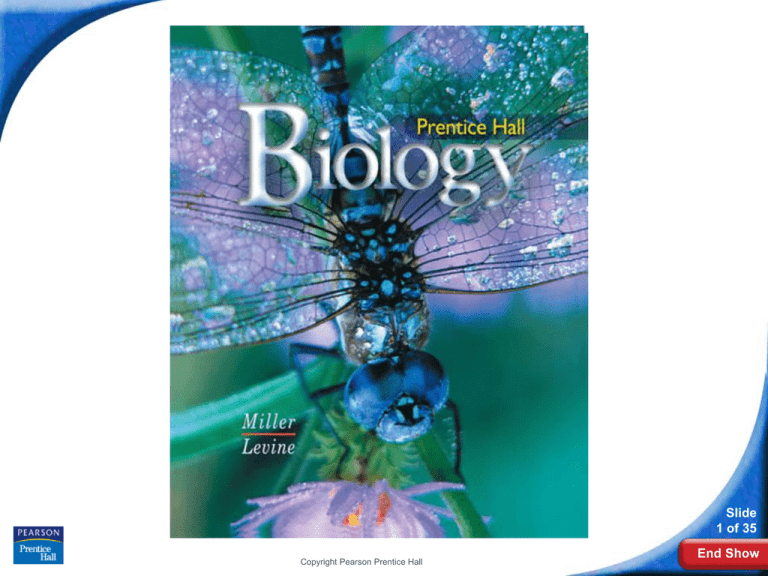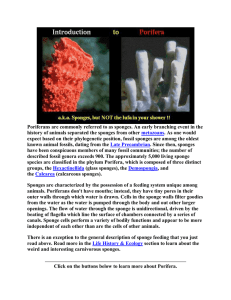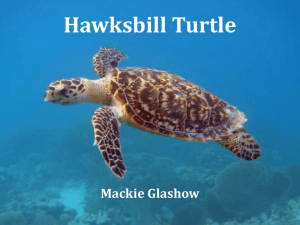
Biology
Slide
1 of 35
Copyright Pearson Prentice Hall
End Show
26-2 Sponges
Slide
2 of 35
Copyright Pearson Prentice Hall
End Show
26-2 Sponges
What is a Sponge?
What is a Sponge?
Sponges are in the phylum Porifera which means
“pore-bearers.”
Sponges live their entire adult life attached to a
single spot.
Slide
3 of 35
Copyright Pearson Prentice Hall
End Show
26-2 Sponges
What is a Sponge?
Why are sponges classified as animals?
Slide
4 of 35
Copyright Pearson Prentice Hall
End Show
26-2 Sponges
What is a Sponge?
Sponges are classified as animals because
they are :
• multicellular
• heterotrophic
• have no cell walls
• contain a few specialized cells
Slide
5 of 35
Copyright Pearson Prentice Hall
End Show
26-2 Sponges
Form and Function in Sponges
How do sponges carry out essential
functions?
Slide
6 of 35
Copyright Pearson Prentice Hall
End Show
26-2 Sponges
Form and Function in Sponges
Form and Function in Sponges
Sponges do not have a mouth or gut, and they
have no tissues or organ systems.
Slide
7 of 35
Copyright Pearson Prentice Hall
End Show
26-2 Sponges
Form and Function in Sponges
Body Plan
Sponges are
asymmetrical; they
have no front or back
ends, no left or right
sides.
Slide
8 of 35
Copyright Pearson Prentice Hall
End Show
26-2 Sponges
Form and Function in Sponges
The body of a sponge
forms a wall around a
large central cavity
through which water is
circulated continually.
Central
cavity
Slide
9 of 35
Copyright Pearson Prentice Hall
End Show
26-2 Sponges
Form and Function in Sponges
Water flow
Water enters through
pores located in the
body wall and leaves
through the osculum,
a large hole at the top
of the sponge.
Osculum
Pores
Slide
10 of 35
Copyright Pearson Prentice Hall
End Show
26-2 Sponges
Form and Function in Sponges
Choanocyte
Choanocytes are
specialized cells that use
flagella to move a steady
current of water through
the sponge.
Pore
Slide
11 of 35
Copyright Pearson Prentice Hall
End Show
26-2 Sponges
Form and Function in Sponges
The movement of water through the
sponge provides a simple mechanism
for feeding, respiration, circulation, and
excretion.
Slide
12 of 35
Copyright Pearson Prentice Hall
End Show
26-2 Sponges
Form and Function in Sponges
Sponges have a simple
skeleton. In harder
sponges, the skeleton is
made of spiny spicules.
Spicule
A spicule is a spikeshaped structure made of
calcium carbonate or
silica.
Slide
13 of 35
Copyright Pearson Prentice Hall
End Show
26-2 Sponges
Form and Function in Sponges
Spicules are made by
archaeocytes, which
are specialized cells
that move around
within the walls of the
sponge.
Archaeocytes
Slide
14 of 35
Copyright Pearson Prentice Hall
End Show
26-2 Sponges
Form and Function in Sponges
Feeding
Sponges are filter feeders.
As water moves through the sponge, food particles
are trapped and engulfed by choanocytes that line
the body cavity.
Slide
15 of 35
Copyright Pearson Prentice Hall
End Show
26-2 Sponges
Form and Function in Sponges
These particles are then digested or passed on to
archaeocytes, who complete the digestive process
and transport digested food throughout the sponge.
Slide
16 of 35
Copyright Pearson Prentice Hall
End Show
26-2 Sponges
Form and Function in Sponges
Respiration, Circulation, and Excretion
Sponges rely on movement of water through their
bodies to carry out body functions.
Oxygen dissolved in the water diffuses into the
surrounding cells.
Carbon dioxide and other wastes, such as
ammonia, diffuse into the water and are carried
away.
Slide
17 of 35
Copyright Pearson Prentice Hall
End Show
26-2 Sponges
Form and Function in Sponges
Response
Sponges do not have nervous systems that would
allow them to respond to changes in their
environment.
However, many sponges protect themselves by
producing toxins that make them unpalatable or
poisonous to potential predators.
Slide
18 of 35
Copyright Pearson Prentice Hall
End Show
26-2 Sponges
Form and Function in Sponges
Reproduction
Sponges can reproduce sexually or asexually.
In most sponge species, a single sponge forms
both eggs and sperm by meiosis.
The eggs are fertilized inside the sponge’s body, in
a process called internal fertilization.
Slide
19 of 35
Copyright Pearson Prentice Hall
End Show
26-2 Sponges
Form and Function in Sponges
Sperm are released from one sponge and are carried
by water currents until they enter the pores of another
sponge.
Slide
20 of 35
Copyright Pearson Prentice Hall
End Show
26-2 Sponges
Form and Function in Sponges
Archaeocytes carry the sperm to an egg.
Slide
21 of 35
Copyright Pearson Prentice Hall
End Show
26-2 Sponges
Form and Function in Sponges
After fertilization, the
zygote develops into a
larva. A larva is an
immature stage of an
organism that looks
different from the adult
form.
Slide
22 of 35
Copyright Pearson Prentice Hall
End Show
26-2 Sponges
The larvae of
sponges are motile.
Water currents
carry the larva until
it attaches to a
surface and grows
into a new sponge.
Form and Function in Sponges
New sponge
Mature sponge
(2N)
Swimming larva
Slide
23 of 35
Copyright Pearson Prentice Hall
End Show
26-2 Sponges
Form and Function in Sponges
Sponges can reproduce asexually by budding or by
producing gemmules.
In budding, part of a sponge breaks off of the parent
sponge, settles to the sea floor, and grows into a new
sponge.
Slide
24 of 35
Copyright Pearson Prentice Hall
End Show
26-2 Sponges
Form and Function in Sponges
In difficult environmental conditions, some sponges
produce gemmules, which are groups of
archaeocytes surrounded by a tough layer of
spicules.
Gemmules can survive freezing temperatures and
drought. When conditions become favorable, a
gemmule grows into a new sponge.
Slide
25 of 35
Copyright Pearson Prentice Hall
End Show
26-2 Sponges
Form and Function in Sponges
Sexual reproduction involves joining haploid gametes
that have been produced by meiosis.
Since the zygote contains genes from both parents,
the new sponge is not genetically identical to either
parent.
Slide
26 of 35
Copyright Pearson Prentice Hall
End Show
26-2 Sponges
Form and Function in Sponges
Asexual reproduction, in contrast, does not involve
meiosis or the joining of haploid gametes.
Asexual reproduction produces offspring that are
genetically identical to the parent.
Slide
27 of 35
Copyright Pearson Prentice Hall
End Show
26-2 Sponges
Ecology of Sponges
Ecology of Sponges
Sponges are important in aquatic ecology.
They provide habitats for marine animals such as
snails, sea stars, and shrimp.
Slide
28 of 35
Copyright Pearson Prentice Hall
End Show
26-2 Sponges
Ecology of Sponges
Sponges containing photosynthetic organisms play
an important role in the ecology and primary
productivity of coral reefs.
The spicules of some sponges look like cross-shaped
antennae.
They focus and direct incoming sunlight to cells lying
below the surface of the sponge—where symbiotic
organisms carry out photosynthesis.
Slide
29 of 35
Copyright Pearson Prentice Hall
End Show
26-2
Click to Launch:
Continue to:
- or -
Slide
30 of 35
End Show
Copyright Pearson Prentice Hall
26-2
In sponges, a spike-shaped structure made of
chalklike calcium carbonate or glasslike silica is
a(an)
a. spicule.
b. archaeocyte.
c. choanocyte.
d. epidermal cell.
Slide
31 of 35
End Show
Copyright Pearson Prentice Hall
26-2
An immature stage of an organism that looks
different from the adult form is a(an)
a. gemmule.
b. larva.
c. archaeocyte.
d. choanocyte.
Slide
32 of 35
End Show
Copyright Pearson Prentice Hall
26-2
Specialized cells that use flagella to move water
through the sponge are
a. gemmules.
b. pores.
c. spicules.
d. choanocytes.
Slide
33 of 35
End Show
Copyright Pearson Prentice Hall
26-2
Sponges are
a. detritivores.
b. carnivores.
c. filter feeders.
d. herbivores.
Slide
34 of 35
End Show
Copyright Pearson Prentice Hall
26-2
Sponges can reproduce
a. sexually only.
b. asexually only.
c. both sexually and asexually.
d. by metamorphosis.
Slide
35 of 35
End Show
Copyright Pearson Prentice Hall
END OF SECTION








